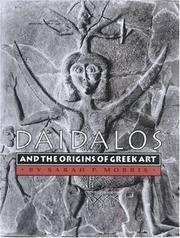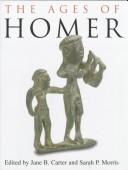| Listing 1 - 10 of 13 | << page >> |
Sort by
|
Book
ISBN: 0300030649 9780300030648 Year: 1984 Volume: 6 Publisher: New Haven, CT ; London : Yale University Press,
Abstract | Keywords | Export | Availability | Bookmark
 Loading...
Loading...Choose an application
- Reference Manager
- EndNote
- RefWorks (Direct export to RefWorks)

ISBN: 069100160X 0691035997 9780691035994 9780691001609 Year: 1992 Publisher: Princeton : Princeton University Press,
Abstract | Keywords | Export | Availability | Bookmark
 Loading...
Loading...Choose an application
- Reference Manager
- EndNote
- RefWorks (Direct export to RefWorks)
Art, Greek. --- Daedalus (Greek mythology) --- Art grec --- Dédale (Mythologie grecque) --- Influence. --- Influence --- Art, Greek --- Dédale (Mythologie grecque) --- Dédale (mythologie grecque) --- Greek art --- Art, Aegean --- Art, Greco-Bactrian --- Dédale (mythologie grecque) --- -Greek art --- Daedalus --- Classical antiquities --- Daedalus (Greek mythology) - Influence. --- Daedalus (Greek mythology) - Influence
Book
ISBN: 9780691241944 Year: 2022 Publisher: Princeton, NJ
Abstract | Keywords | Export | Availability | Bookmark
 Loading...
Loading...Choose an application
- Reference Manager
- EndNote
- RefWorks (Direct export to RefWorks)
In a major revisionary approach to ancient Greek culture, Sarah Morris invokes as a paradigm the myths surrounding Daidalos to describe the profound influence of the Near East on Greece's artistic and literary origins.
Art, Greek. --- Arts --- Greek art --- Art, Aegean --- Classical antiquities --- Art, Greco-Bactrian --- History. --- Daedalus --- Δαίδαλος --- Daidalos --- Taitale --- Dédalo --- Dédale --- Acropolis. --- Aeschylus. --- Ancient Greece. --- Ancient Greek art. --- Ancient Greek comedy. --- Ancient Greek sculpture. --- Ancient Greek temple. --- Anecdote. --- Archaeology. --- Archaic Greece. --- Athenian Democracy. --- Barbarian. --- Baruch Spinoza. --- Battle of Salamis. --- Classical Athens. --- Classical Greece. --- Classical archaeology. --- Classical mythology. --- Colonies in antiquity. --- Copernican Revolution (metaphor). --- Crete. --- Criticism of religion. --- Critique. --- Culture of Greece. --- Cumae. --- Daedalus. --- Deus. --- Erechtheus. --- Etruscan civilization. --- Euripides. --- Explanation. --- Fifth-century Athens. --- First principle. --- Funeral oration (ancient Greece). --- Greco-Persian Wars. --- Greek Philosophy. --- Greek Ship. --- Greek literature. --- Greek mythology. --- Greek name. --- Greek tragedy. --- Greeks. --- Hellenistic-era warships. --- Hephaestus. --- Hermeneutics. --- Herodotus. --- Hesiod. --- Histories (Herodotus). --- Immanence. --- Ionians. --- Iphigenia in Aulis. --- Law court (ancient Athens). --- Literature. --- Lykourgos (king). --- Maimonides. --- Marrano. --- Materialism. --- Medism. --- Mycenae. --- Naval warfare. --- Northern Greece. --- Odysseus. --- Oedipus the King. --- Pantheism. --- Peloponnesian War. --- Persian people. --- Philo of Byblos. --- Philoctetes. --- Philosopher. --- Philosophical analysis. --- Philosophy. --- Phoenicia. --- Phoenician alphabet. --- Phrygians. --- Plutarch. --- Poetry. --- Politics. --- Reality. --- Reason. --- Religio. --- Religion. --- Sanchuniathon. --- Scientific revolution. --- Scythia. --- Sensibility. --- Sola scriptura. --- Sophocles. --- Teleology. --- Temple of Artemis. --- Temple of Olympian Zeus, Athens. --- Terracotta. --- The Persians. --- Theatre of ancient Greece. --- Thebes, Greece. --- Themistocles. --- Theology. --- Thessaly. --- Vitruvius. --- Western Greece. --- Writing.
Book
Abstract | Keywords | Export | Availability | Bookmark
 Loading...
Loading...Choose an application
- Reference Manager
- EndNote
- RefWorks (Direct export to RefWorks)
Book
Year: 2007 Publisher: Liège Austin Université de Liège University of Texas
Abstract | Keywords | Export | Availability | Bookmark
 Loading...
Loading...Choose an application
- Reference Manager
- EndNote
- RefWorks (Direct export to RefWorks)

ISBN: 0292711697 Year: 1995 Publisher: Austin (TX) : University of Texas Press,
Abstract | Keywords | Export | Availability | Bookmark
 Loading...
Loading...Choose an application
- Reference Manager
- EndNote
- RefWorks (Direct export to RefWorks)
Beschaving [Homerische ] --- Civilisation homérique --- Civilization [Homeric ] --- Grèce d'Homère --- Homeric civilization --- Homerisch Griekenland --- Homerische beschaving --- Homerische cultuur --- Homerische tijd --- Homer --- Criticism and interpretation --- Epic poetry [Greek ] --- History and criticism --- Contemporary Greece
Book
ISBN: 9781950446285 9781950446285 Year: 2023 Publisher: Los Angeles The Cotsen Institute of Archaeology Press
Abstract | Keywords | Export | Availability | Bookmark
 Loading...
Loading...Choose an application
- Reference Manager
- EndNote
- RefWorks (Direct export to RefWorks)
Excavations at ancient Methone since 2003 by the Greek Ministry of Culture have uncovered remains from the Late Neolithic period through the fourth-century B.C. destruction by Philip II of Macedon. These discoveries extend the history of the city, a colony of Eretria (Euboia) since the late eighth century B.C., by nearly three thousand years into Greek prehistory. This volume presents results of the project in selected artefacts, burials, and structures representing the chief phases of the city, in chronological order. An introduction covers historical sources, excavations from 2003 to 2013, and the unique location of Methone. Part I details the prehistoric settlement at Methone, from the fourth millennium to 1000 B.C., and the Bronze Age burials. Part II focuses on the copious artifacts and ecofacts from the Early Iron Age "Hypogeion" shaft. Part III presents artifacts and architecture from the Archaic and Classical periods, through the final days of the siege of the city in 354 B.C. The significance of this work lies in its interdisciplinary methods, combining stylistic analysis of artifacts and source-critical philology with natural history, bioarchaeology, materials analysis, and geochemistry, whose results reveal the long-term history of a site crucial to the economic and political history of Classical Greece and the north Aegean.
Excavations (Archaeology) --- Ancient Methone Archaeological Project. --- Methōnē Site (Greece) --- Methōnē (Greece) --- Antiquities. --- Methone Site (Greece) --- Bronze age --- Iron age --- Material culture --- AMAP (Ancient Methone Archaeological Project) --- Methóni (Greece) --- Modon (Greece) --- Greece --- Antiquities --- Human settlements --- Pottery, Ancient
Book
Year: 2007 Publisher: Liège Université de Liège. Histoire de l'art et archéologie de la Grèce antique
Abstract | Keywords | Export | Availability | Bookmark
 Loading...
Loading...Choose an application
- Reference Manager
- EndNote
- RefWorks (Direct export to RefWorks)
Book
Year: 2007 Publisher: Liège : Austin : Université de Liège. Histoire de l'art et archéologie de la Grèce antique University of Texas,
Abstract | Keywords | Export | Availability | Bookmark
 Loading...
Loading...Choose an application
- Reference Manager
- EndNote
- RefWorks (Direct export to RefWorks)
Periodical
Year: 1999
Abstract | Keywords | Export | Availability | Bookmark
 Loading...
Loading...Choose an application
- Reference Manager
- EndNote
- RefWorks (Direct export to RefWorks)
| Listing 1 - 10 of 13 | << page >> |
Sort by
|

 Search
Search Feedback
Feedback About UniCat
About UniCat  Help
Help News
News